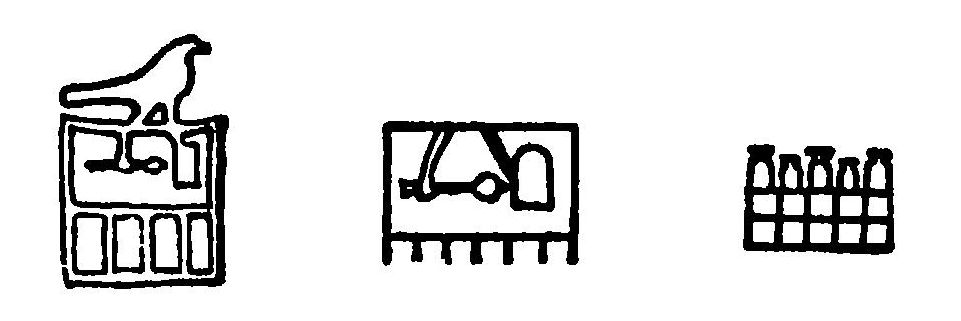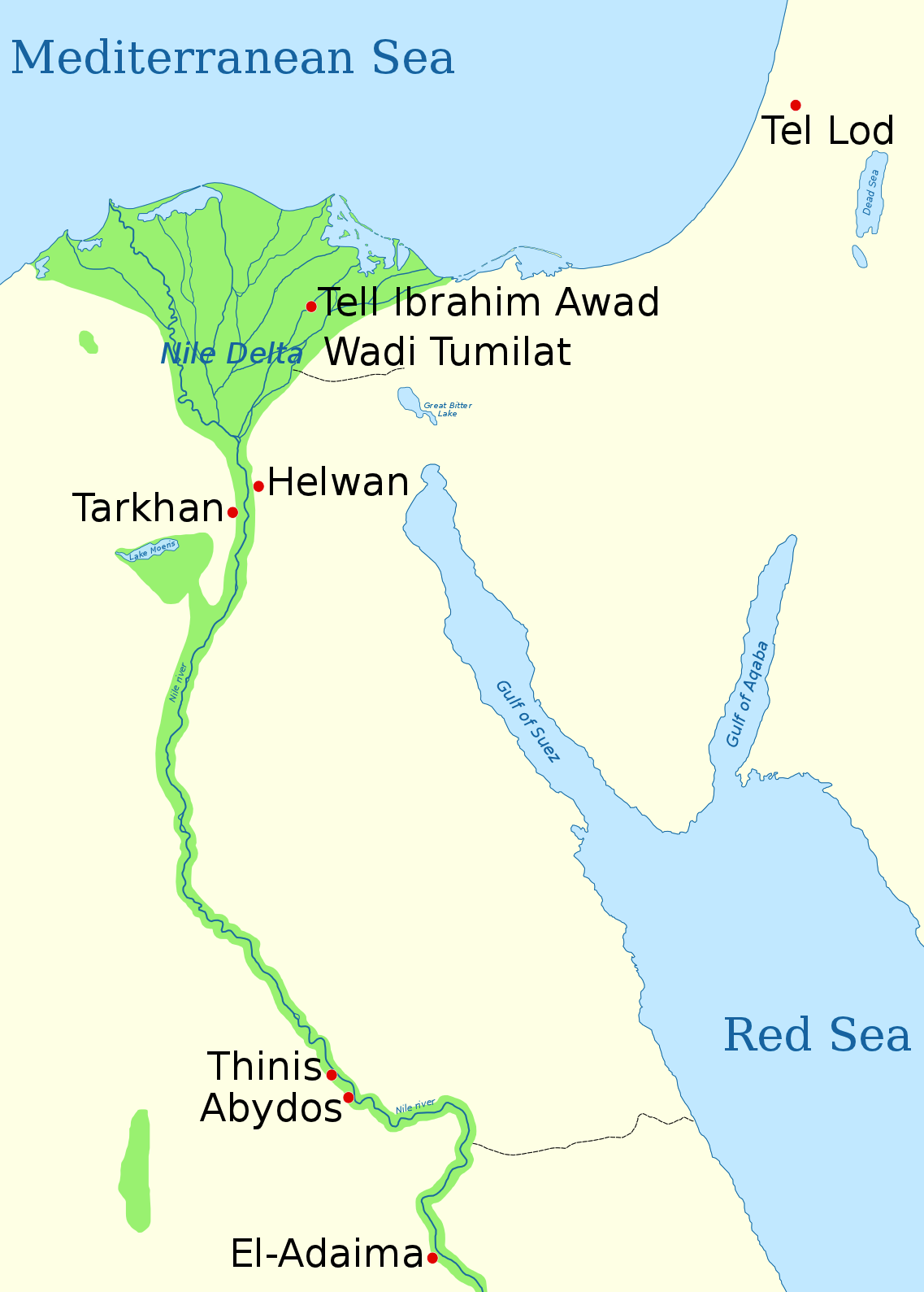|
Narmer
Narmer (, may mean "painful catfish", "stinging catfish", "harsh catfish", or "fierce catfish"; ) was an ancient Egyptian king of the Early Dynastic Period, whose reign began at the end of the 4th millennium BC. He was the successor to the Protodynastic king Ka. Many scholars consider him the unifier of Egypt and founder of the First Dynasty, and in turn the first king of a unified Egypt. He also had a prominently noticeable presence in Canaan, compared to his predecessors and successors. Neithhotep is thought to be his queen consort or his daughter. A majority of Egyptologists believe that Narmer was the same person as Menes. Historical identity Although highly interrelated, the questions of "who was Menes?" and "who unified Egypt?" are actually two separate issues. Narmer is often credited with the unification of Egypt by means of the conquest of Lower Egypt by Upper Egypt. Menes is traditionally considered the first king/pharaoh of Ancient Egypt, and is identified ... [...More Info...] [...Related Items...] OR: [Wikipedia] [Google] [Baidu] |
Narmer Palette
The Narmer Palette, also known as the Great Hierakonpolis Palette or the Palette of Narmer, is a significant Egyptian archaeological find, dating from about the 31st century BC, belonging, at least nominally, to the category of cosmetic palettes. It contains some of the earliest hieroglyphic inscriptions ever found. The tablet is thought by some to depict the unification of Upper and Lower Egypt under the king Narmer. Along with the Scorpion Macehead and the Narmer Maceheads, also found together in the main deposit at Nekhen, the Narmer Palette provides one of the earliest known depictions of an Egyptian king. On one side, the king is depicted with the bulbed White Crown of Upper (southern) Egypt, and the other side depicts the king wearing the level Red Crown of Lower (northern) Egypt, which also makes it the earliest known example of a king wearing both types of headdress. The Palette shows many of the classic conventions of Ancient Egyptian art, which must already have ... [...More Info...] [...Related Items...] OR: [Wikipedia] [Google] [Baidu] |
Menes
Menes ( ; ; , probably pronounced *; and Μήν) was a pharaoh of the Early Dynastic Period of ancient Egypt, credited by classical tradition with having united Upper and Lower Egypt, and as the founder of the First Dynasty. The identity of Menes is the subject of ongoing debate, although mainstream Egyptological consensus inconclusively identifies Menes with the Naqada III ruler Narmer or his successor, the First Dynasty pharaoh Hor-Aha. Name and identity The name ''Menes'' is first documented in the work of Manetho, an Egyptian historian and priest of the relatively late Ptolemaic period. Manetho noted the name in Greek as Μήνης (transliterated: ''Mênês'').Manetho, Fr. 6, 7a, 7b. Text and translation in ''Manetho'', translated by W.G. Waddell (Cambridge: Harvard University, 1940), pp.26–35 An alternative Greek form, Μιν (transliterated: ''Min''), was cited by the fifth-century-BC historian Herodotus, but this variant appears to be unrelated, the result of c ... [...More Info...] [...Related Items...] OR: [Wikipedia] [Google] [Baidu] |
Hor-Aha
Hor-Aha (or Aha or Horus Aha; ) is considered the second pharaoh of the First Dynasty of Egypt by some Egyptology, Egyptologists, while others consider him the first one and corresponding to Menes. He lived around the 31st century BC and is thought to have had a long reign. Identity Name The commonly used name ''Hor-Aha'' is a rendering of the pharaoh's Ancient Egyptian royal titulary#Horus name, Horus-name, an element of the Ancient Egyptian royal titulary, royal titulary associated with the god Horus, and is more fully given as ''Horus-Aha'' meaning ''Horus the Fighter''. Manetho's record ''Aegyptiaca'' (translating to History of Egypt) lists his Greek name as Athothis, or "Athotís". For the Early Dynastic Period (Egypt), Early Dynastic Period, the archaeological record refers to the pharaohs by their Horus-names, while the historical record, as evidenced in the Turin King List, Turin and Abydos King List, Abydos king lists, uses an alternative royal titulary, the Ancient ... [...More Info...] [...Related Items...] OR: [Wikipedia] [Google] [Baidu] |
Early Dynastic Period (Egypt)
The Early Dynastic Period, also known as Archaic Period or the Thinite Period (from Thinis, the hometown of its rulers), is the era of ancient Egypt that immediately follows the unification of Upper and Lower Egypt in . It is generally taken to include the First Dynasty and the Second Dynasty, lasting from the end of the archaeological culture of Naqada III until , or the beginning of the Old Kingdom. With the First Dynasty, the Egyptian capital moved from Thinis to Memphis, with the unified land being ruled by an Egyptian god-king. In the south, Abydos remained the major centre of ancient Egyptian religion; the hallmarks of ancient Egyptian civilization, such as Egyptian art, Egyptian architecture, and many aspects of Egyptian religion, took shape during the Early Dynastic Period. Before the unification of Egypt, the land was settled with autonomous villages. With the early dynasties, and for much of Egypt's history thereafter, the country came to be known as "The Tw ... [...More Info...] [...Related Items...] OR: [Wikipedia] [Google] [Baidu] |
Scorpion II
Scorpion II (Ancient Egyptian: possibly Selk or Weha), also known as King Scorpion, was a ruler during the Protodynastic Period of Upper Egypt (). Identity Name King Scorpion's name and title are of great dispute in modern Egyptology. His name is often introduced by a six- or seven-leafed golden rosette or flower sign. This emblem can be found on numerous objects from the Dynasty 0 and Dynasty I periods; it vanishes until the end of the Third Dynasty, when it re-appears under high-ranked officials, such as '' Khabawsokar'' and '' A'a-akhty'' (both dated to the end of the Third Dynasty). Its precise meaning has been intensely discussed; the most common interpretation is that of an emblem meaning 'nomarch' or 'high lord'. During the protodynastic and early dynastic eras, it was evidently used as a designation for kings; in much later periods, it was bestowed on high-ranked officials and princes, especially on those who served as priests for the goddess Seshat. Thus, t ... [...More Info...] [...Related Items...] OR: [Wikipedia] [Google] [Baidu] |
First Dynasty Of Egypt
The First Dynasty of ancient Egypt (Dynasty I) covers the first series of Egyptian kings to rule over a unified Egypt. It immediately follows the unification of Upper and Lower Egypt, by Menes, or Narmer, and marks the beginning of the Early Dynastic Period, when power was centered at Thinis. The date of this period is subject to scholarly debate about the Egyptian chronology. It falls within the early Bronze Age and is variously estimated to have begun anywhere between the 34th and the 30th centuriesBC. In a 2013 study based on radiocarbon dates, the accession of Hor-Aha, the second king of the First Dynasty, was placed between 3111 and 3045 BC with 68% confidence, and between 3218 and 3035 with 95% confidence. The same study placed the accession of Den, the sixth king of the dynasty, between 2928 and 2911 BC with 68% confidence, although a 2023 radiocarbon analysis placed Den's accession potentially earlier, between 3011 and 2921, within a broader window of 3104 to 2913. T ... [...More Info...] [...Related Items...] OR: [Wikipedia] [Google] [Baidu] |
Neithhotep
Neithhotep or Neith-hotep () was an ancient Egyptian queen consort who lived and ruled during the early First Dynasty. Archeological evidence may indicate that she may have ruled as pharaoh in her own right, and as such would have been the earliest known female monarch in history.Owen Jarus: ''Name of queen Neith-hotep found at Wadj Ameyra''. In: ''Live Science, 19. January 2016'' (online). (English) She was subsequently considered to be the wife of unified Egypt's first pharaoh, , and the mother of Hor-Aha. She was o ... [...More Info...] [...Related Items...] OR: [Wikipedia] [Google] [Baidu] |
Pharaoh
Pharaoh (, ; Egyptian language, Egyptian: ''wikt:pr ꜥꜣ, pr ꜥꜣ''; Meroitic language, Meroitic: 𐦲𐦤𐦧, ; Biblical Hebrew: ''Parʿō'') was the title of the monarch of ancient Egypt from the First Dynasty of Egypt, First Dynasty () until the Roman Egypt, annexation of Egypt by the Roman Republic in 30 BCE. However, the equivalent Egyptian language, Egyptian word for "king" was the term used most frequently by the ancient Egyptians for their monarchs, regardless of gender, through the middle of the Eighteenth Dynasty during the New Kingdom of Egypt, New Kingdom. The earliest confirmed instances of "pharaoh" used contemporaneously for a ruler were a letter to Akhenaten (reigned –1336 BCE) or an inscription possibly referring to Thutmose III (–1425 BCE). In the early dynasties, ancient Egyptian kings had as many as ancient Egyptian royal titulary, three titles: the Horus name, Horus, the prenomen (Ancient Egypt), Sedge and Bee (wikt:nswt-bjtj, ''nswt-bjtj''), and ... [...More Info...] [...Related Items...] OR: [Wikipedia] [Google] [Baidu] |
Ka (pharaoh)
Ka, also (alternatively) Sekhen, Jürgen von Beckerath: ''Handbuch der ägyptischen Königsnamen'', Münchner ägyptologische Studien, Heft 49, Mainz : P. von Zabern, 1999, available online see p. 36-37 was a Predynastic pharaoh of Upper Egypt belonging to Dynasty 0. He probably reigned during the first half of the 32nd century BC. The length of his reign is unknown. Name The correct reading of Ka's name remains uncertain. There are vessel inscriptions which show a serekh with a typical ''Ka''-symbol, both written upright correctly, but there are also inscriptions presenting an upright serekh with an upside-down ''Ka''-symbol inside. The second form of that writing indicates a reading as Sekhen (meaning "to embrace someone") rather than ''Ka''. It was also thought to be the birth name of Narmer. Because the reading of the name is so uncertain, Egyptologists and writing experts such as Ludwig David Morenz prefer a neutral reading as "King Arms". Ka's personal name may have ... [...More Info...] [...Related Items...] OR: [Wikipedia] [Google] [Baidu] |
Upper Egypt
Upper Egypt ( ', shortened to , , locally: ) is the southern portion of Egypt and is composed of the Nile River valley south of the delta and the 30th parallel North. It thus consists of the entire Nile River valley from Cairo south to Lake Nasser (formed by the Aswan High Dam). Name In ancient Egypt, Upper Egypt was known as ''tꜣ šmꜣw'', literally "the Land of Reeds" or "the Sedgeland", named for the sedges that grow there. In Biblical Hebrew it was known as and in Akkadian it was known as . Both names originate from the Egyptian '' pꜣ- tꜣ- rsj'', meaning "the southern land". In Arabic, the region is called Sa'id or Sahid, from صعيد meaning "uplands", from the root صعد meaning to go up, ascend, or rise. Inhabitants of Upper Egypt are known as Sa'idis and they generally speak Sa'idi Egyptian Arabic. Geography Upper Egypt is between the Cataracts of the Nile beyond modern-day Aswan, downriver (northward) to the area of El-Ayait, which places modern- ... [...More Info...] [...Related Items...] OR: [Wikipedia] [Google] [Baidu] |
Ancient Egypt
Ancient Egypt () was a cradle of civilization concentrated along the lower reaches of the Nile River in Northeast Africa. It emerged from prehistoric Egypt around 3150BC (according to conventional Egyptian chronology), when Upper and Lower Egypt were amalgamated by Menes, who is believed by the majority of List of Egyptologists, Egyptologists to have been the same person as Narmer. The history of ancient Egypt unfolded as a series of stable kingdoms interspersed by the "Periodization of ancient Egypt, Intermediate Periods" of relative instability. These stable kingdoms existed in one of three periods: the Old Kingdom of Egypt, Old Kingdom of the Early Bronze Age; the Middle Kingdom of Egypt, Middle Kingdom of the Middle Bronze Age; or the New Kingdom of Egypt, New Kingdom of the Late Bronze Age. The pinnacle of ancient Egyptian power was achieved during the New Kingdom, which extended its rule to much of Nubia and a considerable portion of the Levant. After this period, Egypt ... [...More Info...] [...Related Items...] OR: [Wikipedia] [Google] [Baidu] |









